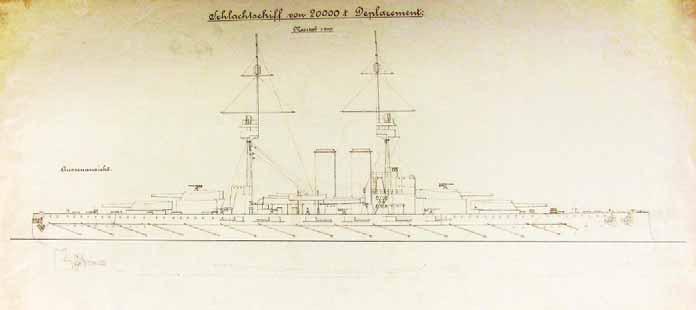dation for new, broader slipways. Within a year and at a great expense, new workshops and two 265 m long and 35 m wide slipways of reinforced concrete (Battleship slipway No I and No II) were constructed. The territory of the shipyard reached 127,000 square meters in 1912, including the new embankments. It was evident too, that the capacity of Danubius’s machine shop in Budapest 263 was not sufficient for such a great order. In 1911, the Hitelbank initiated the fusion of the Danubius and the Ganz és Tsa Gépgyár (Ganz and Co. Machine Factory) under the name of Ganz és Tsa. Danubius Hajó-, Waggon- és Gépgyár (Ganz and Co. Danubius Shipyard, Railway Wagon and Machine Factory). This fusion created Hungary’s largest industrial complex. After the fusion the so-called Naval Machinery Department in Budapest switched over to autonomous machinery design instead of merely copying the plans of the Navy. To help that, the shipyard bought some licenses from Great Britain and Germany.264 The most important of them, the license of German AEG turbines was bought in October 1909.265 Beside these the Danubius had for a long time possessed the license to manufacture Babcock-Wilcox boilers. On 13 December 1910, the MTK inspected the Danubius yard. The report of the MTK stated that the great slipways for battleships would be completed only in the spring of 1912. Considering that and the unprepared state of the Danubius, they stated that the building time of the battleship would be 42 months rather than 30 months prescribed by the Navy.266 In fact, the total building time of the battleship Szent István from signing the contract to the commissioning reached 55 months. Beside the one battleship the Navy ordered from the Ganz and Co. Danubius two of the three 3,500 ton scout cruisers of the 1911 program, the H and the I which were later named Helgoland and Novara. According to the agreement of January 1911 all the six 800 ton destroyers (Tátra class) were ordered from the Danubius. These were the first ships not only built, but designed by the Hungarian shipyard. Originally all the 250 ton torpedo boats were to be ordered from the Austrian industry. The Navy increased the number of the boats from twelve to twenty-seven in February 1913. In the same year the Navy ordered sixteen torpedo boats from the Danubius, partly as a compensation
for the Hungarian industry because the submarines intended for Hungary were ordered in Germany. The total worth of these orders excluding the battleship was 41.1 million Kronen. This sum alone was more than twice the total worth of the Navy’s orders given to Danubius between 1906 and 1910 (18.1 million Kronen).267 After the fusion of the Danubius with the Ganz and Co. in 1911, the annual reports of the Ganz stated that the shipbuilding branch was loss-making while the published production data were false. Most probably this served to conceal the huge profit of the warship building.268 The Schlachtschiff VII When Korvettenkapitän Alfred von Koudelka, the secretary of the Marinekommandant, Admiral Montecuccoli, negotiated in November 1906 with members of the Hungarian government on the future dreadnoughts in Budapest, Commerce minister Ferenc Kossuth made clear that Hungary would assent to future dreadnought construction only if one third of the costs would be spent in Hungary and one of the battleships would be built by the Danubius Shipyard. Hearing this news Montecuccoli allegedly cried out in his hotel room: “That ship will be never completed!”269 The prophecy of Montecuccoli almost came true, but at last she was completed well past the deadline. To come to terms with Hungarian politics was a long process. The Navy had certain worries in connection with the quality of the Hungarian built ships, but the Hungarian dreadnought was a question of politics: she was the sine qua non of Hungary’s vote for the whole class. The negotiations between the Navy, the Hungarian government and the Danubius Shipyard started in 1909 and lasted until the end of 1910. The Navy in July 1909 agreed with the Hungarian government on the principles: in exchange of voting the dreadnoughts and developing the Danubius at public expense, 50 percent of the orders for new vessels including one of the four battleships would go to Danubius.270 Once the Hungarian political crisis was past the Austrian and Hungarian delegations voted the 312 million Kronen extraordinary credit for the Navy in February and March 1911. After the vote of the delegations, the Navy finally could legally
— 82 —






























